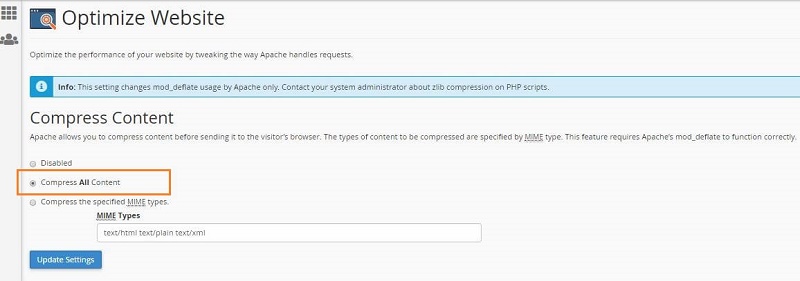Websites are crucial these days as they allow a company to reach their potential customers. It is very significant for a website to perform well, as an underperforming website can cause a company to lose valuable customers and business. In this post we will learn some major causes of website being slow and how to speed up your website?
When we say ‘an under performing website’ what we mean is a website that loads slow, and is not able to display all the information, or offer all the services and features at an instant, which would have, otherwise, influenced the visitors to take a call of action. Sometimes, the websites might load so slow that it might have even frustrate the visitor, ultimately hampering the image of the company in the eyes of the potential customers.
It is, therefore, important to pay attention to the performance of the website, and in this case, ensuring that the website loads quickly. Now, there are various reasons that might cause a website to load slow, however, one of the main reasons is slow response from the server or an overloaded server.
Slow Responding or Overloaded Web server
It’s quite established that for a website to function, it needs to take web hosting services, offered by various web hosting companies. Now, a hosting service providing company simply offers a web server to the website, where all its data and information are stored. Every time a user opens a website in a browser, the browser requests all the information and data from the same server.
Normally, the server is able to meet the demands of the browser in seconds, the website loads in no time, and the user gets what he wants. However, there are situations when the browser doesn’t receive all that data and information on time, which causes the website to load slow, resulting in the user having a bad experience. This situation is typically coined as Slow Responding Server or Overloaded Server.
It occurs when the features of the hosting package don’t quite meet the needs of the website, because of which it is not able to entertain all the visitors opening the portal. Whenever an organization chooses a hosting company to host their website, it should put a lot of thinking into what the features of the package are, so that it suits the popularity of the website.
Let’s take bandwidth for an instance. Your hosting package should offer enough bandwidth to your website so that it is able to serve all the visitors, trying to log on to it, at any given time. The higher your bandwidth capacity is, the more visitors your website is able to handle in a given time. In simple words, a package that offers 2 TB bandwidth is definitely better than the one that offers 1 TB bandwidth, as the former one allows the website to serve more requests than the latter one.
Your bandwidth combined with all the other features like storage, memory and vCPUs ensure that your website gives its best performance. And if these features in your package are not standard, you’re bound to get slow response from your server, which results in your site opening real slow, and the visitors not getting what they need on time.
Now, you need to understand that the hosting package that you choose for your website is only a little bit at fault when it comes to getting slow response from the server. It is the web hosting companies that are mostly at fault for overloading the server, especially because of their policies concerning the features offered in their web hosting packages.
Web Hosting Types: Standard Shared Web Hosting and Cloud Hosting
In general, there are two major types of web hosting services offered. The first one is Standard Shared Web Hosting, and the second one is Cloud Hosting. One of the major differences among the two is that of popularity. Without a doubt, Standard Shared Web Hosting is more popular than Cloud Hosting, and why not! Standard Shared Web Hosting Packages are way more affordable than Cloud Hosting Packages. And turns out, people generally go for the price before anything else.
The second reason why Standard Shared Web Hosting is more favored is because it is offered by the biggest web hosting service providing companies, and has really big names and brands associated to it. Also turns out that people generally go for the most familiar lines and companies, when it comes to choosing a service provider.
The companies and individuals, owning a website, tend to choose web hosting service by considering mainly the above mentioned factors, and without analyzing other crucial aspects that hamper the performance of their website. If we are to completely ignore, these two aspects, Cloud Hosting is much better than Standard Shared Web Hosting, as it is proven to help websites perform greatly, especially by eliminating all risks of slow response from the server.
To understand all this in detail and to Speed Up Your Website, we need to discuss how these two web hosting types work, in terms of providing their services to various websites.
Standard Shared Web Hosting vs. Cloud Hosting
The features that are offered in a regular Standard Shared Web Hosting Package is normally shared between numbers of users, despite the fact that the company claims for them to be dedicated. When you go for a package that says 25 GB of storage, you expect for the 25 TB of storage to be completely yours, but it’s not so. The case is quite similar even when it comes to bandwidth and memory.
First of all, there are restrictions on the number of files that you can store. Secondly, all your unused space is sometimes shared by another user. A lot of companies claim to offer unlimited space and bandwidth, but that is just a trick to attract the customers. When you read their user agreement, you actually come to know that there are restrictions in almost everything, and there is no way to monitor the resources that you’re using.
Now, because of all these restrictions, a lot of times, the servers aren’t able to meet the requests sent by the browsers from all over, which causes them to slow down and overload. On the other hand, the website owners are left in a dilemma. For them, every feature of the hosting package is unlimited, and they don’t really know that these hidden restrictions are the main reasons why their website is opening slow and giving a bad performance.
On the other hand, the features offered in a Cloud Hosting Package are quite dedicated. So, when you’re offered 1 TB memory, 25 GB storage and 1 TB bandwidth, it all belongs to you. This features single handedly causes your site to give its best performance, and there is no chance of overloading or slow responding server. Also, you can always monitor how much of the resources you’re using at all times, which makes the entire process quite transparent.
Now, when you compare the features of Standard Shared Web Hosting and Cloud Hosting, you actually realize that you’re not getting your money’s worth with the former type of hosting as most of the times, you’re paying for features that you’ve not even using. Plus, there’s always a risk for the site to underperform. While, in case of Cloud Hosting, since you’re able to monitor all the resources that you’re using, you only pay for what you’ve used. Read our previous post on 10 best cloud hosting service providers.
Why Go For Cloud Hosting
Speed Up Your Website
Cloud Hosting, is the ultimate solution to tackling slow responding or overloaded server, and to speed up your website all together. Cloud Hosting is very fast and dedicated and there is no neighboring website, belonging to any other organisations or personnel, utilizing your server resources. So, you are on your own, utilizing all the server’s resources in a dedicated manner.

Apart from the regular storage, memory and bandwidth limitations, there are no other limitations, as is the case with Standard Shared Web Hosting. When you go for cloud hosting, whose plan cost starts from $3 per month, you can actually host more than 10 websites in there, while also benefiting with fast dedicated cloud VPS (Virtual Private Server). Cloud hosting is actually much better and affordable than a slow Shared Web Hosting from companies like 1&1 or GoDaddy. They also offer free SSL installation in all the websites, and the SSL renews automatically for lifetime.
With Cloud Hosting, in case of unexpected rise in the number of visitors, you can increase your resource limitations, and when the number of visitors go down, you can decrease it. This way, you’re able to handle slow responses, while paying only for the resources that you’ve used for a certain amount of time. This kind of flexibility is offered only by Cloud Hosting.
So, the next time, you go for a hosting service, don’t just go for the price or the brand, but rather the features of the package. They have a great impact on your site’s speed. The hosting service that you choose can make and break your site’s performance, so take an informed decision.
Now let’s see other ways to optimize and speed up your website.
Some more ways to Speed Up Your Website
#1 Compress the website’s contents
Compress the content that your website serves and it includes CSS (Cascading Style Sheets), Javascript, Images and any other types of files such as videos or PDF.
a.) For images:- You should really make sure all the images that you are uploading are compressed using the proper compression tool. I use tinypng.com, an online tools to compress images. If you have not already done this before, no need to worry as you can still download the images from your media upload folder and compress them all, then upload them to the server. Make sure you do not rename the files.
If your website is built on WordPress, then your job is much more easier as there are various plugins that compress your current images and all the future uploads. I like the WP Smush plugin – Smush Image Compression and Optimization By WPMU DEV. It really simplify the job by taking care of all the previous and future images.
b). For CSS and Javascript Files:- It is very common to notice that most of the websites have lots of separate CSS files and they all load one by one. Sometimes the css file to load first is of no use as it just get replaced or overridden by the other CSS files with higher precedence or the inline or on page CSS. You should really find all such unwanted stray or unused CSS file and eliminate them to decrease the website load times. You may also want to combine multiple CSS into one and multiple Javascript files into one. Having CSS, Javascript and images loading from another server such as CDN(Content Delivery Network) or subdomain also helps a lot in decreasing the website load time while minimizing the server load as well.
If you are using a cPanel based hosting, you can enable content compression from cPanel dashboard also. Simply login to cPanel of your website by typing domain.com/cpanel or by logging into your hosting account and then go to the cPanel option. Once logged in, look for section named “Software” and click “Optimize Website”.

It will take you to a new page with three option to choose from “Disable, Compress All Content, Compress the Specified MIME type”. Yo can simply select “Compress All Content” and click “Update Settings”.

#2. Enable gZip Compression
gZip is a server side compression that reduces the size of your HTML, CSS, JavaScript files by upto 70%. It make your website load faster by delivering highly compressed contents. Follow the instruction here to enable gZip.
#3. Install a Cache Plugins
For WordPress there are multiple plugins such as WP Super Cache and W3 Total Cache among the most famous cache plugin. What they do amazing is, they compress the whole website in few files by combining all the CSS, JavaScript files and minifying them before they are served to a user. They are very easy to setup, simply install, activate and enable them.
If you are running a custom HTML and PHP website then you may need to install and enable the mod_cache or mod_file_cache module on your server. For this you should login to your Server through SSH and root user privilege. Again, root access with SSH is mostly not possible with shared hosting services, you should have a VPS like cloud hosting or any dedicated hosting with your full control on server resources. Once you SSH to your server, simply type the following command to enable the mod_file_cache (in case of Apache Web Server).
sudo a2enmod file_cache
now open the Apache configuration file by typing the following command:
sudo nano /etc/apache2/apache2.conf
And finally, add the following cache directive to apache2.conf file to enable and configure cache on your server. The only problem with such setup is that you need to put the path to each file you want to enable caching for. Add each file path separated by space as shown below save the file by pressing CTRL+X and press Y then hit enter. Restart the Apache server and the caching will be enabled.
CacheFile /var/www/html/index.html /var/www/html/login.html /var/www/html/test.php sudo service apache2 restart
to enable cache on Nginx based web server, follow the instructions as per Nginx official docs.
#4. Limit or Minimize the number of Social Sharing Buttons
Sometime we install one or more plugin or script to show social sharer – Social Sharing buttons, so that user can share the article from our website to their Social Media profile. Often it is useful in driving some more traffic and making the website famous, but on a slow shared hosting environment, this could slower your website more. So, try using very few share buttons or no buttons at all.
These were few important steps to speed up your website. There are lot more ways to optimize the website further, but applying these basic important website optimizing factors will help you a lot. If you’d like further explanations, or have any question you could simply ask us through the comment form below. We’d love to hear from you.




































